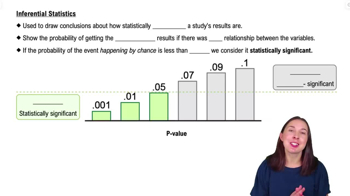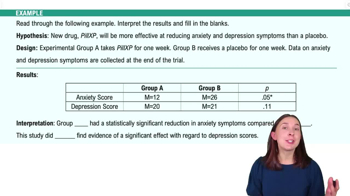Table of contents
- 1. Introduction to Psychology1h 43m
- 2. Psychology Research2h 20m
- 3. Biological Psychology2h 41m
- 4. Sensation and Perception28m
- 5. Consciousness and Sleep32m
- 6. Learning41m
- 7. Memory34m
- 8. Cognition37m
- 9. Emotion and Motivation35m
- 10. Developmental Psychology33m
- 11. Personality48m
- 12. Social Psychology41m
- 13. Stress and Health41m
- 14. Psychological Disorders44m
- 15. Treatment47m
2. Psychology Research
Evaluating Research Findings
Struggling with Psychology?
Join thousands of students who trust us to help them ace their exams!Watch the first videoMultiple Choice
Which of the following p values would indicate that a statistically significant relationship was found between two variables?
A
p < .01
B
p < .05
C
p < .09
D
Both a and b
 Verified step by step guidance
Verified step by step guidance1
Understand the concept of p-values: In hypothesis testing, a p-value helps determine the significance of your results. It represents the probability of observing the data, or something more extreme, if the null hypothesis is true.
Recognize the common significance levels: In psychology and many other fields, a p-value less than 0.05 (p < 0.05) is typically considered statistically significant. This means there is less than a 5% probability that the observed results are due to chance.
Identify stricter significance levels: A p-value less than 0.01 (p < 0.01) indicates an even stronger evidence against the null hypothesis, with less than a 1% probability that the results are due to chance.
Evaluate the given options: Compare each p-value option to the common significance levels. Both p < 0.01 and p < 0.05 are considered statistically significant, as they fall below the 0.05 threshold.
Conclude which options indicate significance: Based on the evaluation, both p < 0.01 and p < 0.05 indicate statistically significant relationships, aligning with the common standards in psychological research.

 6:00m
6:00mWatch next
Master Descriptive Statistics – Measures of Central Tendency with a bite sized video explanation from Hannah Gordils
Start learningRelated Videos
Related Practice















![Ethical Guidelines in Psychology [AP Psychology Unit 1 Topic 6] (1.6)](https://img.youtube.com/vi/ilq2nGO7_QA/mqdefault.jpg)





























